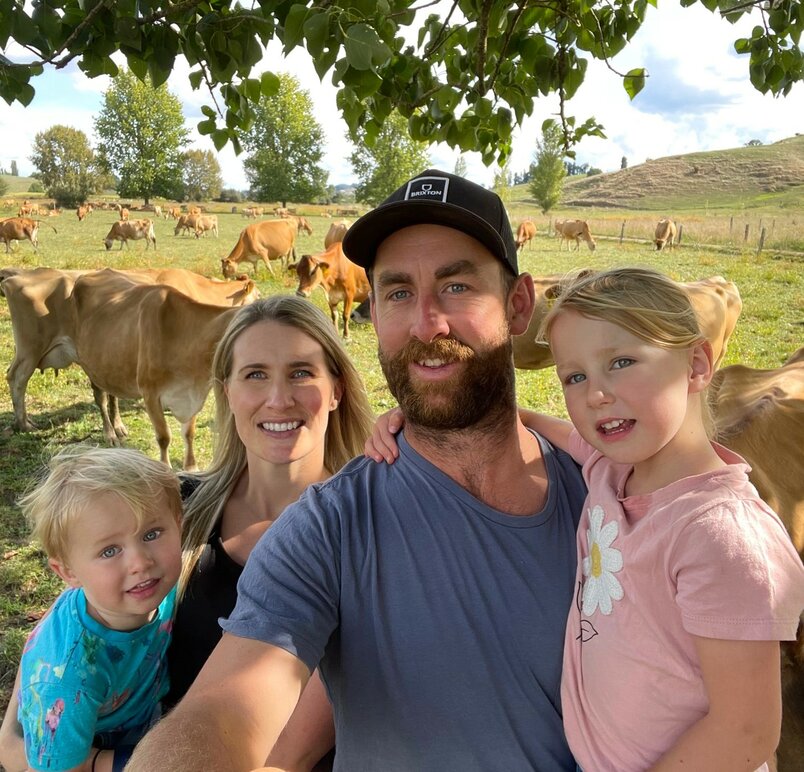When Jersey breeders and farmers Michelle and Shaun Good were seeking to better protect their herd they turned to Tru-Test technology to help maintain and improve strong reproductive performance.
For pedigree Jersey breeders Michelle and Shaun Good, their steeply contoured Otorohanga farm has been home for six seasons. Last year the couple added a nearby leased property and a new run off to form a second milking platform. They have 800 mainly Jersey girls – a 400 cow commercial herd and a similar sized high BW pedigree herd which has supplied a number of bulls to the AB industry.
“We’ve put so much effort into building the genetics of our herd, we really wanted to protect that,” says Michelle. “Our thinking was that we needed some form of technology to support our business growth and to simplify operations while maintaining our strong reproductive performance. The first step was to seek out collars to detect heat at least as well as we can, ideally better.”
After scanning the market for nearly two years, the couple identified smart collars — and a list of non-negotiables beyond the core function of accurate and reliable heat detection. These nonnegotiables were seamless integration with their herd management system MINDA records to avoid updating multiple systems, a clean, easy-to-use interface with easy-to-interpret information, and an overall cost-effective solution with responsive support.
Michelle and Shaun opted for Datamars Livestock’s Tru-Test Active Collar Tags and added on an Autodrafter and Walk over Weighing. The Tru-Test Active Collar Tags monitor cow behaviour and movement 24/7 to give an indication of when each animal is on heat with 99% accuracy.
An initial hurdle was full farm coverage which was necessary to ensure every cow is monitored day and night. Hills, gullies, and nooks are common in the central North Island creating dead spots on farms that many systems couldn’t deliver on without expensive infrastructure.
Michelle says Datamars came back with a cost-effective solution. That clever problem solving, the collars themselves, and the commitment to continued algorithm development to increase insights from their on-farm data made Datamars a clear winner.
For the first six weeks of using the collars, the couple did paddock checks and used tail paint and scratchies to compare with the collar insights and make sure the collars were working as they expected.
“The collars are about 99% accurate and they’ve met that expectation so far.” The collars have also picked up a few animals that Michelle and Shaun would have otherwise missed. “To date, there have been three or four animals that fall in that space that the collars have picked up and we otherwise probably wouldn’t have mated. That is just in those first few weeks of mating. We hope to pick up more of those animals and end up with a lower empty rate.”
High-end embryo transfer work which the Goods employ throughout the AB period to fast track their genetic improvement provides another validation point for the Tru-Test Active Collars. Before embryo placement, all potential surrogate cows have their ovaries scanned to make sure the cow has had a really good cycle, and everything looks good.
“The collars have reliably identified cows which would make the best recipients for embryos — cows which have really long and strong heats. Information from the collars has been predominantly in sync with the ovary scans. It’s been an unexpected bonus to pick the best recipients for the ET work using the collars and we hope it will result in a higher conception rate.”
There are a number of other savings too. Paint, scratchies, and paddock checks, all added time and cost to the Good’s operation previously. Another saving may be pregnancy scanning. The Good’s do two scans each year but say if collars can accurately tell them when animals are still cycling beyond the mating period, then scanning maybe a thing of the past.
“Long term impact of the collars is about making our business more efficient. Hopefully, they will help our focus toward herd improvement. The more cows we get in calf, the more we can pick up health issues before they become clinical, and the more we can monitor and oversee our herd the more options it gives us around breeding and discretionary culling so we can improve our herd.”
Michelle believes technology such as what she and Shaun are using is important for the whole industry, not just their farming operation. “Technology helps support herd improvement. That is how we see the collars and Datamars Livestock fitting in to our business.”
Michelle says she is looking forward to reaping the value the combined data that Tru-Test Active Collar Tags and Datamars Livestock Walk Over Weighing will deliver over the coming seasons.
